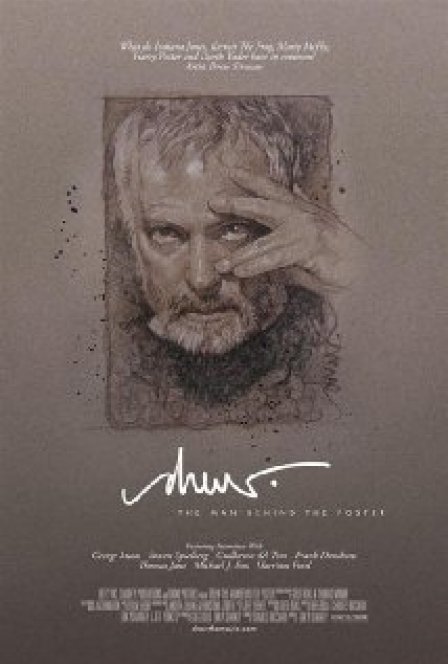My appreciation for cinema began with unhealthy amounts of B-horror and exploitation flicks, as well as the so-called video nasties. There was no internet back then, and I had little to no information as to what to expect from any given film: all I had was the juicy enticement of the VHS tape’s cover. It was all about tapping into the allure, the ability to dig into our imaginations, our references, our expectations. Drew Struzan is man with a striking ability in manipulating these elements, and during his lifetime work he designed some of the most memorable and iconic hand painted film posters of the past decades. Even if you’ve never heard of Drew Struzan, you’ve certainly seen his artwork and quite possibly have some of these images engraved in your nostalgic mind (or maybe even reblogged on your Tumblr).
Mr. Struzan himself is a soft spoken, tranquil, surprisingly humble, and all around straightforward nice guy who married his high school sweetheart. It’s very easy to sympathize with him right from the beginning of the new documentary, Drew: The Man Behind the Poster , which greatly helps considering we hear about Drew’s life and work for the upcoming 90 minutes. We also learn that it was Drew’s wife, Dylan, who helped him out throughout his early college years and during his starving artist period, in which they pretty much lived below the poverty line. Although not much screen time is given to depicting these early days in his career, it’s one of the most interesting threads in the documentary: for one, I learned that he actually started out by drawing album covers, having done some famous pieces such as Black Sabbath’s Sabbath Bloody Sabbath and the exceptional cover for Alice Cooper’s Welcome to My Nightmare .
After this brief story of how Drew managed to break big into Hollywood, the film becomes a collection of behind-the-scenes curiosities and anecdotes as to how individual posters came to be. The premise is simple, but it works surprisingly well, but my main issue with Erik Sharkey’s documentary is that too much time is spent on endless praise for and adulation of Drew Struzan by famous Hollywood personalities — it’s only after an hour into the film that someone finally attempts to discuss the larger cultural implications behind movie posters themselves. One particularly interesting moment concerns the posters Drew did for several of Jim Henson’s Muppet movies. The producers had originally envisioned a poster featuring a studio photograph of the actual Muppets. However, a photographic image of the Muppets shows them as nothing more than, well, Muppets. I couldn’t help but feel that a major opportunity was lost here. Take this little-known poster by Drew, for example. Now, I haven’t seen this forgotten, possibly straight-to-video, cheap 1980s attempt at neo-noir called Into the Fire (AKA The Legend of Wolf Lodge), but I’m willing to that it is nothing close to the brilliance of the cheesy, deliciously gorgeous, pulp pastiche cliché that the poster depicts. As Thomas Jane says when talking about Drew’s poster for Masters of the Universe: “I want to see that movie. I’ll never be able to, because that movie doesn’t exist, but I want to see it.”
There is also an argument in the film regarding Drew being one of the last major representatives of a bygone era, in which artful, hand-painted posters are now being replaced by glossy fashion magazine style photoshops. Being extremely suspicious of any nostalgia-soaked romanticism, especially when discussing art history, I remain skeptical of this idea. Posters were and still are part of the marketing budget for feature films in an ever more cutthroat market. Even during Drew’s pinnacle, his art style wasn’t the norm, and arguably only managed to survive in the industry due to patronage by the likes of colossi such as George Lucas and Steven Spielberg. Once again, I couldn’t help but feel as if the film could have taken this opportunity to explore more thought-provoking sub-themes: who else was working during this period with movie poster art (Roger Kastel for example is briefly shown in his studio alongside his famous poster for Jaws)? How does Drew himself feel about the fact that his personal artwork is largely ignored, and that he’s only known by his merchant work for major film companies? Some of Drew’s personal work is very briefly shown at the end of the film, but instead of a compelling discussion about art and market, precious screen time is wasted on some irrelevant story about how Drew was once ripped off by some partner decades ago.
Like many so many documentaries before it, Drew: The Man Behind the Poster will work best when viewed by someone with prior interest in the topic at hand, but there are plenty of us (especially those in their late 20s and onwards) who will have fond memories of the images created by this man. The well-paced editing makes for a smooth ride when moving Drew’s life story forward, and the constant flow of poster art eye candy makes for a more than welcome distraction from the barrage of talking heads. If you’re a film buff, it’s a no brainer. I was kept largely interested throughout the whole experience, and left with a desire to go after Drew Struzan’s work and film poster history, which is more of an impact than most documentaries have. My only gripe is the fact that we could have gotten so much more from such a largely underexplored subject.

